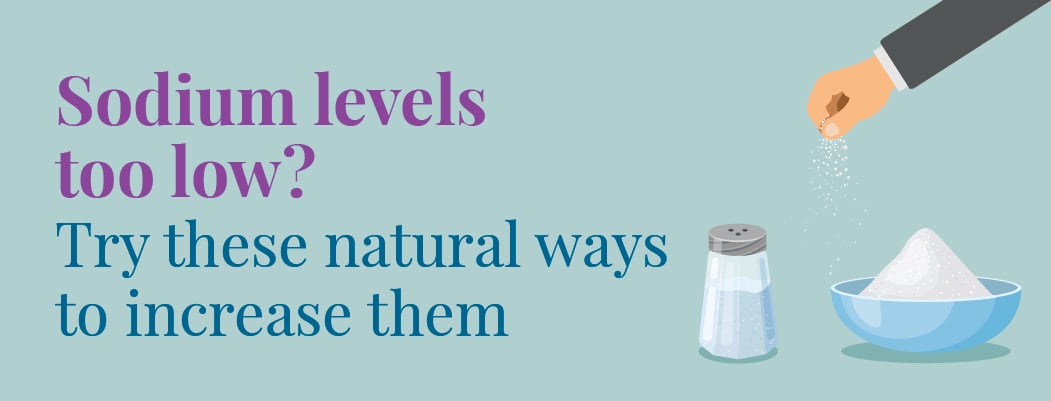How to increase sodium levels
February 13, 2023

Hyponatremia, also known as low blood sodium, is a condition in which sodium concentration in the blood is lower than normal. Sodium is a mineral that plays a critical role in regulating the fluid balance in the body, transmitting nerve impulses, and maintaining muscle and nerve function. When sodium levels in the blood drop too low, it can cause a wide range of symptoms and health complications.
Table of Contents
Causes
There are many possible causes of hyponatremia. One of the most common causes is an excessive fluid intake, which can dilute the sodium in the blood. Other causes include certain medications and medical conditions that affect the kidneys or adrenal glands and hormonal imbalances.
Symptoms of hyponatremia
It can range from mild to severe and may include
- Headache
- Nausea and vomiting
- Confusion
- Muscle cramps
- Lethargy
- Seizure
Treatment
Treatment for hyponatremia depends on the underlying cause and the severity of the condition. Mild cases of hyponatremia may not require any treatment, while more severe cases may require doctors’ aid to raise the sodium levels in the blood. In addition to medical treatment, addressing any underlying factors that may have contributed to the development of hyponatremia, such as excessive fluid intake or medication use, is important.
Preventing
hyponatremia involves maintaining a healthy body balance of fluids and electrolytes. This can be achieved by staying hydrated but not overhydrating and avoiding excessive intake of fluids, especially during intense physical activity. If you are taking medications that can cause hyponatremia, be sure to talk to your doctor about the risks and potential side effects. It is also important to monitor your sodium levels regularly, especially if your medical condition puts you at risk for hyponatremia.
Hyponatremia is a condition that can have serious health consequences if left untreated. Therefore, it is important to be aware of the potential causes and symptoms of hyponatremia and to seek medical attention if you experience any of these symptoms. With proper treatment and preventive measures, it is possible to manage hyponatremia and maintain a healthy body balance of fluids and electrolytes.
Home remedies to increase your sodium levels
If you are looking to increase your sodium levels, here are some effective ways to do so:
Increase your salt intake
Consuming more salt is the most straightforward way to increase your sodium levels. Salt, also known as sodium chloride, is our diet’s primary sodium source. However, it is essential to note that consuming too much salt can lead to high blood pressure, which can increase the risk of heart disease and stroke. Therefore, monitoring your salt intake and staying within the recommended daily limits is crucial.
Studies recommend consuming no more than 2,300 milligrams of sodium per day, which is approximately one teaspoon of salt. However, if you have certain medical conditions, such as hypertension, diabetes, or kidney disease, you may need to limit your salt intake further.
Consult your doctor to determine the appropriate amount of salt for your specific needs.
Consume more sodium-rich foods
In addition to salt, many other foods are naturally high in sodium. These include:
- Processed and canned foods, such as soups, sauces, and snacks
- Cheese and other dairy products
- Meat and poultry
- Seafood, such as shrimp and oysters
- Vegetables, such as beets, carrots, and celery
- Condiments, such as soy sauce and ketchup
- Incorporating more of these foods into your diet can help increase your sodium levels.
However, it is essential to pay attention to the nutritional value of these foods and consume them in moderation.
Drink sports drinks or electrolyte solutions
If you have low sodium levels due to excessive sweating or dehydration, sports drinks or electrolyte solutions may help increase your sodium levels. These drinks contain a mixture of water, sugar, and electrolytes, including sodium, potassium, and chloride. They are designed to replenish fluids and electrolytes lost during physical activity.
However, it is crucial to note that some sports drinks may contain high sugar levels, which can lead to weight gain and other health problems. Look for sports drinks with balanced electrolytes and low sugar content.
Manage underlying medical conditions
Finally, suppose you have low sodium levels due to an underlying medical condition, such as kidney disease or adrenal insufficiency. In that case, managing the condition to increase your sodium levels is essential. Depending on the specific condition, this may involve medication, dietary changes, or other interventions.
Drinking vegetable juice
Drinking vegetable juice can be an easy way to meet your daily fruit and vegetable intake. However, it’s important to note that many packaged vegetable juices have added salt, which increases sodium levels. Therefore, fresh vegetable juice is recommended as it naturally contains healthy amounts of sodium, which can benefit your body in various ways.
Canned vegetables
Canned vegetables are another option, but they often contain high levels of salt. To reduce the salt content, you can drain and wash them for a few minutes, which may lower their sodium levels by 9-23%. Nonetheless, fresh vegetables are always a better choice, and if you opt for canned vegetables, be sure to clean them properly.
For instance, a 100g serving of canned peas contains around 250mg of sodium, which is approximately 30-40% of the recommended daily value (DV). Similarly, a 100g serving of canned asparagus contains around 700mg of sodium, which is also 30-40% of the DV. Hence, consuming fresh vegetables is highly recommended over canned vegetables.
When to seek medical assistance?
Consult with Nephrologist for anyone who develops severe signs and symptoms of hyponatremia, such as nausea and vomiting, confusion, seizures, or loss of consciousness. Also, call your doctor if you know you are at risk of hyponatremia and are experiencing nausea, headaches, cramping or weakness.
Summary
In conclusion, maintaining the proper sodium balance in your body is essential for your overall health and well-being. If you have low sodium levels, incorporating more sodium-rich foods, consuming sports drinks or electrolyte solutions, and considering sodium supplements can help increase your sodium levels.
People also ask
1.How can I raise my sodium level at home?
Consume foods that are naturally high in sodium, like pickles, olives, and cured meats. You can also add salt to your food or drink sports drinks that contain electrolytes.
2.What to drink to get sodium levels up?
Drinks that can help raise your sodium levels include sports drinks that contain electrolytes, like Gatorade. You can also drink broth or bouillon, which is high in sodium, or tomato juice, which is a good source of sodium.
3.Which fruit is high in sodium?
Most fruits are not high in sodium, but there are some exceptions. One relatively high sodium fruit is the avocado, which contains around 10 mg of sodium per 100 grams. However, compared to other sources of sodium, this is relatively low. Generally, fruits are low in sodium and are not a significant mineral source.








